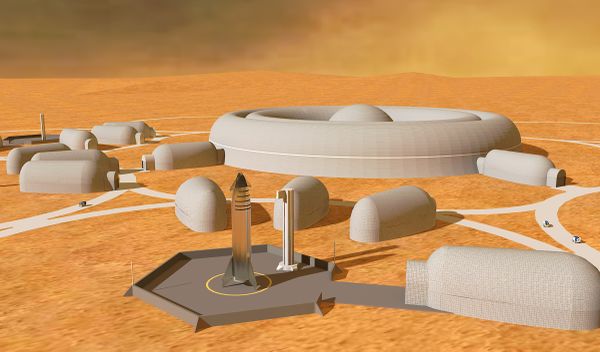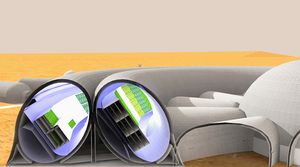Gravity
Mars has a mass of 6,419 · 1023 kg. Compared with Earth this is only a little bit more than a tenth. This results in a lower gravity as the planet is also less dense than Earth. (Mars' surface is closer to the centre of the planet, so the surface gravity is 0.38 of Earth, not 1/10.)
The gravitational acceleration is 3,71 m/s², compared to 9,81 m/s2 on Earth. The resulting weight of any body on the surface of Mars is only a bit more than a third, compared with the same body on Earth. Mass and inertia remain the same, however.
Contents
Impact on physics and nature
- Dust storms on Mars reach high altitude. Scientists found the cause in the low gravity, allowing the sand grains to bounce much higher.
- The low gravity and lack of continental drift has allowed the growth of the highest mountain in the solar system, e.g. Olympus Mons.
- A rock thrown on Mars will fly much further than on Earth.
- The lower gravity results in the atmosphere reaching higher. The atmosphere is 'puffier' and less dense. This impacts radiation protection; it takes 2.63 times more air, to give the same weight of air (air pressure) as on Earth in Mars' gravity. If Mars had an atmospheric pressure of 1 bar, it would provide 2.6 times the radiation protection as the same pressure on Earth. So even tho Mars' air pressure is 0.06 bar, it provides radiation protection of 0.15 times that of Earth.
- It is much easier to get to orbit from Mars. In particular, a single stage to orbit rocket is feasible.
- Engineering projects to get to orbit from Mars' surface are easier. This includes Mass drivers, Sky ramps, and Space elevators.
Impact on humans
The development of human embryos might be different. Also, the long term consequences for the health of human beings is unclear. Constant physical exercise has proven to be beneficial on the ISS to reduce calcium loss and maintain muscle mass. However the difference between no gravity and Low gravity is still unknown. A very useful experiment to run on the International Space Station would be to make a centrifuge with Mars' gravity inside, and see how plants and animals (mice perhaps) would react to living and reproducing in Mars' gravity, but so far, this experiment has never run.
The absence of gravity during interplanetary travel could also undermine the fitness of explorers or settlers to perform their jobs upon their arrival at Mars. However, many Mars Missions (for example: Mars Direct) will spin the space craft on a long teether anchoring it to the expended third stage booster. By varying the length of the cable and the speed of the spin, either Mars or Earth gravity can be provided while in deep space.
See also Low gravity for a way to mitigate this problem.
Potential methods of preventing calcium loss
It has been suggested that the trans-mars habitat have a long cable attached to the spent third stage booster to act as a counter mass. By rotating the system, the astronauts would experience 1 gee for the duration of the trip to Mars. This would render the problems of long duration zero gravity mission moot.
If a zero gee mission IS chosen, then daily exercise appears to reduce, but not eliminate, calcium loss in a zero-gravity environment. Two hours/day has limited calcium loss to 12%, and 4 hours/day limited it to 5%, during stays on Mir and the International Space Station.
The stress placed on bones by normal gravity causes a certain amount of interstitial fluid flow within bones, which may be important in preserving bone calcium. It might be possible to stimulate this effect using, as a medication, a signaling protein called a growth factor that allows fluid to leak out of blood vessels.
If research identifies a specific gene as the regulator of low-gravity calcium loss, then a more refined version of this approach might be possible. Scientists could attempt to design a medication that targets this specific gene and holds its expression at the same level as it would be in Earth gravity.[1]
Walking on Mars will be different from walking on Earth. Gait studies() have sown that the transition from walking to running would happen at a different speed than on Earth. The change in weight with the conservation of mass and inertia would change the angles required during cornering and for directional changes.
Impact on technology
- The pressure on bearings for the same service is lower, causing less friction and abrasion. Or lighter bearings can be used.
- A space elevator is easier to build. (Mars' slightly longer day, & lower gravity makes a space elevator possible with current materials.)
Impact on plants
- Plants have grown normally on the ISS and should grow on Mars. The effect on their internal structure of the Low gravity is unknown.
Impact on Settlement design
For the 2019 Mars Society settlement design contest, Kent Nebergall proposed the Eureka base design. This design addresses most of the potential problems that might arise from Low gravity by building the settlement about a pair of rotating ring structures capable of simulating Earth gravity by centripetal force. Usually planned for spaceships, artificial gravity using centripetal force could be implemented on Mars.
The design[2] addresses a number of social and technological issues, as well as artificial gravity.
References
- ↑ McCormack PD. (2005). Chronic health hazards in human space exploration. http://www.marspapers.org/paper/McCormack_2005.pdf
- ↑ https://macroinvent.com/wp-content/uploads/2019/03/Eureka-Mars-Settlement-Concept.pdf








